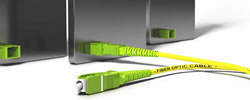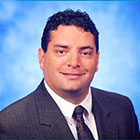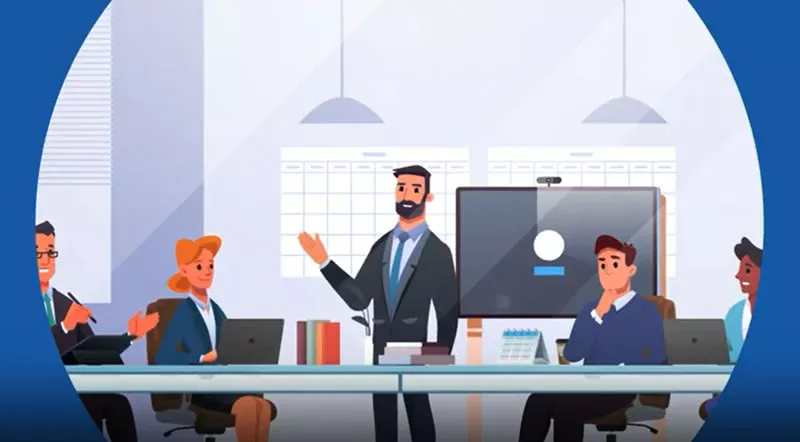Broadband Linkup
Multiple Content Streams, Single Content Pipe
“The format of the media we consume is continually evolving. The devices that deliver it change, too.”

Alexander "Shony" Podarevsky
Senior System Engineer, Promptlink Communications
The format of the media we consume is continually evolving. The devices that deliver it change, too. On this episode of the Broadband Linkup podcast, Alexander Podarevsky, Senior Systems Engineer for Promptlink, sat down with host Sean Heath to discuss the move towards content over data connection.
The outside of a set-top box has remained the roughly the same for over 25 years, although they have shrunken to smaller and smaller footprints. But according to Podarevsky, it’s dramatically different on the inside.
“All the televisions started as analog television to deliver motion pictures to the customers’ homes and after that (the content) gets just simply bigger and bigger and the amount of services and the quality of services grows dramatically since the establishing of this industry," he said.
The initial system of transmission over airwaves has almost been completely replaced by content over data lines. This shift from analog video signals to digital content delivery is shifting how video is consumed and how OTT video has changed the topography of home entertainment.
“In the future… I think everything will be tied to just a data pipe and it doesn’t matter what data pipe you have; everything will be delivered to your TV set," he said.
0:20-1:05
Welcome to Broadband Linkup. I’m your host, Sean Heath. The way that we consume media and entertainment is constantly changing, and it has been since the first motion picture was created without any sound. The environment, the technology that we use is changing so rapidly it’s hard to keep up to be honest. Although what we are consuming is changing rapidly, the methods we use to consume are also changing rapidly. The technology is expanding exponentially and that’s what I want to talk to my guest about today. The guest on the podcast is Senior Systems Engineer for Promptlink Communications, Alexander Podarevsky. Alexander, how are you today?
[Alexander Podarevsky]
1:08-1:11
I’m doing fantastic. Thank you for asking.
[Sean Heath]
1:11-1:43
Now you’ve been in the industry for a while, so you’ve seen the literal evolution of media delivery to our homes and offices. Not just strictly from a testing standpoint but just from an overall view of this technology, how big have the changes really been? From the time you started in this industry, I want to say 2003, I think that’s right. From 2003 to current day, have the changes just been ridiculous?
[Alexander Podarevsky]
1:43-3:48
It was significant, if not to say the more. But when I started to work with this technology, I already jumped almost to the last cart of the modern technology because television itself has a huge, huge, huge history prior 2003 when I started to work on this. But like all the television started as analog television to deliver motion picture to the customers’ homes and after that it gets just simply bigger and bigger and the amount of services and quality of services grows dramatically since the establishing of this industry. So the initial, as I mentioned, initial technology was relying on simply analog television because that was the maximum of that time and eventually everything started to go digital. So the first technologies were digital television, standard definition. And then as more and more advanced CPU or microprocessors gets introduced to the market, everything started to go higher and higher and eventually grows from the analog television to digital over the coaxial cable then nowadays everything go to the digital television over the DOCSIS, over the fiber, over whatever, whatever media it is. And in the future, it’s probably I think everything will be tied to just the data pipe and it doesn’t matter what data pipe you have, everything will be delivered to your TV set.
[Sean Heath]
3:48-4:12
So Alexander, as we talk about all of the different types of information and entertainment that we absorb now through our televisions or through our connections into our homes, and one of those I guess links in the chain has been the set-top box. Does that technology really changed the way you have to approach testing networks to make sure everything’s going smoothly?
[Alexander Podarevsky]
4:12-5:54
Yes, of course. Because the way we consume media traffic, by media traffic, it means like entertainment video, it also changes over the last probably, I don’t know, like 30, 40 years. Well, it was evolving since television was invented. So the set-top boxes, it’s small, tiny little units which connected to the television set to provide you motion picture or nowadays it’s even more integrated services. It’s also evolved because when they started, there was just a standard definition. It was analog interfaces. It was pretty straightforward how to test them. Just connect them, test them, and then high-definition technology comes with testing HDMI with its own technical difficulties as well as set-top box technology evolves over time because everything started as the playing an analog television with probably some encryption. And later on, everything started to go digital with the DVB-C or DAC or DNCS devices and nowadays it’s everything, it’s video over data channel. So all of that is pretty, pretty difficult to maintain.
[Sean Heath]
5:54-6:04
With the advances that you’re able to utilize, do you see a significant improvement in the accuracy of the testing that you do now?
[Alexander Podarevsky]
6:04-7:52
Well, we focused on the functional testing mainly, which means we want to make sure that the device which will be tested on our platform will be deployed to the customer location and the customer will consume traffic with excellent rate of service or like excellent quality of service, let’s say, and all the interfaces that he expect to work will be working as designed and all the quality of the video pictures that he receives on his television set will be great as well because there’s a lot of things involved in modern digital technology to deliver television to the customer set-top boxes including the delay, pixelation, packet loss, all of that will significantly affect the quality of the motion picture that customer will see on his television. And what we are doing we want to make sure that those things during the testing, it will not be affected by the media, by the network delivery of the media data, but the device itself will perform flawlessly without adding additional possible errors or pixelation or any other distortion that customer will be able to see.
[Sean Heath]
7:52-8:23
Now we’ve gotten to the point, as you mentioned, that the set-top box is really starting to handle much more complex direction of traffic, whether it’s sound or video or a data, and that leads us to the OTT or the over the top as, I guess, the new standard for managing our media consumption, whatever form that may take. Is OTT going to become the standard for content delivery moving forward?
[Alexander Podarevsky]
8:23-10:19
Actually it depends. It’s hard to predict where the technology will lead to, but the way I will see the video and media actually will progress in the future as they will obstruct from the actual data pipe that comes to customer’s house and works on top of whatever customer has. So if you have the DSL line, DOCSIS, cable, fiber, Wi-Fi, 5G cellular, it doesn’t matter. Everything will go as a media over data and eventually customer will be able to see fantastic, crisp images on their television.
By the way, you mentioned that, uh set-top boxes have to handle significantly more than they’re used to. Yes, that’s true because first of all of the resolution becomes bigger and bigger. So we are going to high definition then 4K then 8K and in years’ future that’s number one. Number two, as the video codecs and audio codecs evolves so there are significantly more computational requirements for this at the boxes nowadays to process all of those data streams in order to deliver high quality content to the end users. So then, yes, the set-top boxes have to work harder and we need to test them more carefully in order to qualify for the high quality video and an audio delivery to the end user.
[Sean Heath]
10:19-10:30
Is there something about current trends in the industry that would surprise people that maybe they’re not aware of but something that you see constantly?
[Alexander Podarevsky]
10:30-11:01
It depends. People who is involved in this technology, nothing will surprise because only market will decide what actually will be in the future because there’s multiple technology. Concurrent technologies are trying to find their way to the consumer market, but only consumer market will decide which of those technologies will be dominant in the future.
[Sean Heath]
11:01-11:21
Now one thing that is happening is there quite a few companies that are trying to move the majority of their Triple A or the Authorization, Authentication, and Accounting, and then their integration applications, they’re moving that to the cloud. With the years of experience that you have, I’m curious, what’s your opinion of that move?
[Alexander Podarevsky]
11:21-13:19
I understand why this happens because instead of tidying to its own infrastructure and hosting own infrastructure in house for these kinds of stuff, there are leading companies who are making those things almost an industry standard. And if I’m small operator, it’s very, very simple for me. I just buy the hardware for the set-top boxes and sign up contract with those providers and I’m good to go. From the other standpoint, from us as testers, it gives us additional challenges because we need to work with those cloud-based infrastructures and for us it’s also difficult to test all of those because when we test a device, as I mentioned before, we need to make sure that the device works fantastic. And if we found some discrepancies, we want to make sure that these discrepancies caused by the device itself, not by the delivery network, and if we have those services outsourced into the cloud, then we need to make sure that the either connection between the testing product, their testing system and the cloud is great or we have to mimic those functionalities and embed it into a testing system such a way so it will become standalone. So usually, we are moving cloud into the system.
[Sean Heath]
13:19-14:13
And I think specifically in this space, we’re getting to a point where the next big thing is neither software nor hardware. They have to evolve in tandem. They have to be coordinated because if you have excellent hardware but bad software to run it, you can’t fully leverage the power of the hardware. And if you have fantastic software, but you have bad hardware, then the hardware can’t handle all the complex instructions and abilities that you’re asking it to perform. Do you think that need to combine software and hardware moving forward? Is that going to force more partnerships from just a basic construction level, more companies to start working together earlier in the process to put things out in tandem?
[Alexander Podarevsky]
14:13-15:17
I hope so actually because to be honest, if we will standardize more and more of this technology, this means that more companies has to work together as a team in order to… deployment of such a system smoother. It’s like what happened with the networking technologies over time, like many vendors who works together in order to standardize couple of protocols, and after that, our life is easy and fantastic because like when you type something in web browser, you don’t think on what kind of server it’s running, what kind of technology you’re using. It just simply works. So the similar approach has to be done in this because otherwise it will be where anybody challenging to evolve to something better.
[Sean Heath]
15:17-15:29
Today on the podcast, it’s been my pleasure to have a conversation with Alexander Podarevsky. He’s the Senior Systems Engineer for Promptlink Communications. Alexander, thank you so much for taking the time today. I really have enjoyed this.
[Alexander Podarevsky]
15:29-15:29
Pleasure was mine and thank you for having me. It was a great, big discussion that we had.

How Technology is Improving the Broadband User Experience
Chris Boring
VP, Sales and Marketing, Promptlink Communications

El mundo está más dependiente al wifi. ¿Lo podemos diagnosticar apropriadamente?
David Mosquera
Director, Latin American Sales, Promptlink Communications

More ISPs Are Offering ‘White Glove’ Wi-Fi Service for Better Consumer Experience
Chris Boring
VP, Sales and Marketing, Promptlink Communications

How to Detect Noise in Cable Communications
Foad Towfiq
CEO, Promptlink Communications

What to Watch for at SCTE Cable-Tec Expo
Chris Boring
VP, Sales and Marketing, Promptlink Communications

Cable-Tec Attendees Have Been ‘Out of Control Amazed’ with Network NoiseHawk
Foad Towfiq
CEO, Promptlink Communications

Multiple Content Streams, Single Content Pipe
Alexander "Shony" Podarevsky
Senior System Engineer, Promptlink Communications

Restauración de equipos es la estrategia rentable y ecológica para una industria de telecomunicaciones creciente
David Mosquera
Director, Latin American Sales, Promptlink Communications









